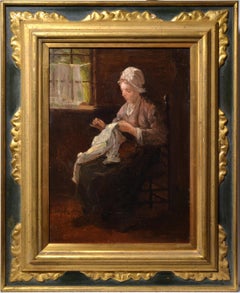Santi di Tito
Ritratto di Nobildonna
Olio su tavola, Sec. XVI, cm 74x61; con cornice 116x100x9
Con procedere degli studi su Santi di Tito, del quale è stata recentemente precisata la nascita fiorentina , si viene sempre più definendo come non solo una delle personalità più interessanti della scena artistica fiorentina, ma anche come il più interessante ritrattista cittadino della seconda metà del Cinquecento.
L'attribuzione di questo ritratto al pittore, che nell'impresa dello Studiolo di Francesco I fu uno dei maggiori innovatori fra i giovani riuniti da Vasari e Borghini, appare subito evidente per l’inconfondibile disegno ovale e fermo del volto, reso con un incarnato compatto dai toni rosati che si accende di naturalistiche notazioni epidermiche ma anche di una puntuale figurazioni degli elmenti decorativi dell’abito e dell’acconciatura. Sempre coerente con i modi pittorici di Santi è poi la pittura compatta con la quale vengono definiti i piani semplificati del volto delle donna, che conservano una notazione di luce e di naturale sensibilità in linea con i dettami controriformati dei quali il pittore fu uno dei più fedeli osservanti nella scena fiorentina. Sempre tipica di Santi di Tito è poi la ferma e volumetrica rappresentazione del torso e dell’abito definito nei piccoli intagli della stoffa ma allo stesso tempo semplificato nei volumi delle maniche e del busto. Ancora di santi ci sembra la notazione luministica con la quale è rilevato il disegno dell’abito attraverso stesure compatte ma sottili e trasparenti, oppure è resa la gorgiera bianca che aggiunge una luce netta all’intero dipinto. Una simile scelta pittorica appare nel Ritratto di Guido Guardi coi figli, esposto alla mostra Il Cinquecento a Firenze, (Palazzo Strozzi, 21 settembre 2017 – 21 gennaio 2018, n. IV. 5, pp. 156-157), dove, pur in un ritratto maschile, Santi di Tito usa la medesima cifra formale nella resa dei volti e delle gorgiere.
Pur nell'attenzione alle caratteristiche fisionomiche, Santi di Tito conserva, infatti, una cifra disegnativa sempre evidente e riconoscibile pur col passare degli anni, un carattere stilistico che sostiene, con volumi saldi, ogni sua differente prova pittorica. Ne sono un esempio dipinti quali il Ritratto di donna con Figlia, già in collezione Koelliker2, oppure il Ritratto di Lucrezia (Emilia) e Sinibaldo di Niccol Gaddi3, tutti databili agli anni settanta del Cinquecento proprio per la stereometrica definizione delle forma. Col passare degli anni, invece, tale carattere di ascendenza bronzinesca sembra cedere sempre più in favore di una pittura più morbida e sensibile, chiamata a raggiungere esiti di naturalezza sempre maggiore. Dipinto emblematico per seguire tale percorso rimane il già citato Ritratto di Guido Guardi con i figli , dove Santi di Tito ha effigiato il capofamiglia subito dopo il suo ritorno da Roma, fra il 1564 e il 1568, al tempo in cui il Guardi commission al pittore anche una pala con una Natività per la cappella di famiglia a San Giuseppe. L’uomo, seduto su uno scranno, sembra rimandare per la posa arcaizzante alla ritrattistica di primo Cinquecento, alla quale Santi di Tito s’ispira anche per le pieghe frante ma scultoree dell’abito. Sulla stessa tavola, probabilmente verso la fine degli anni settanta del Cinquecento, il pittore venne chiamato ad aggiungere le effigi di figli, quando probabilmente l’opera era già in cornice, e lo fece con una pittura più svolta e libera, in modo da raggiungere effetti naturalistici di maggiore sensibilità.
Anche nel Ritratto di donna in esame, i volumi saldi e potenti della figura spiccano sul fondo monocromo della parete con un’evidenza che farebbe pensare alle figure eseguite dalla fine degli anni Settanta del Cinquecento, al pari, appunto dei due figli di Guido Guardi.
Nato a Firenze nel 1536, Santi di Tito si form prima da Bastiano da Montecarlo per passare poi dal Bronzino, del quale conserv la preferenza per volumi luminosi e torniti, a cui aggiunse un'attenzione per la chiarezza compositiva e il naturalismo richiesti dai dettami della Controriforma, che lo portarono a guardare allo stile di
Scipione Pulzone...


